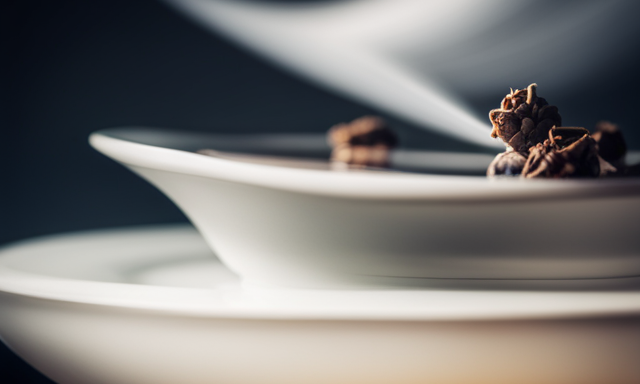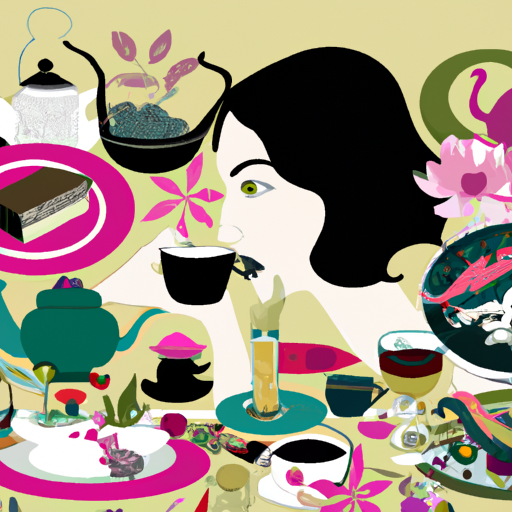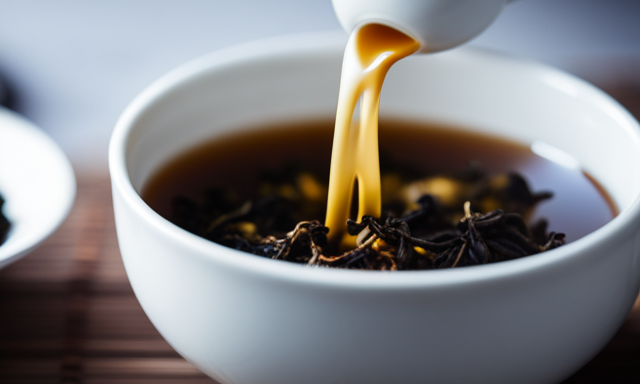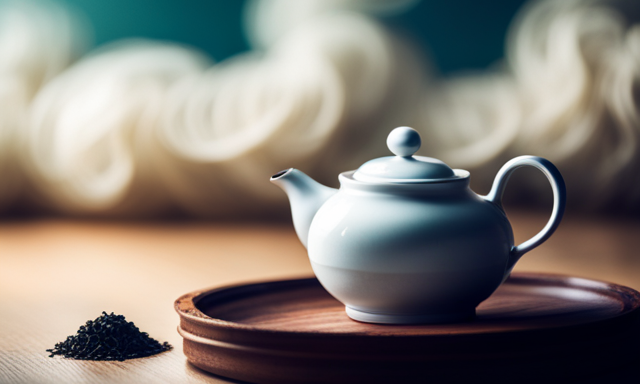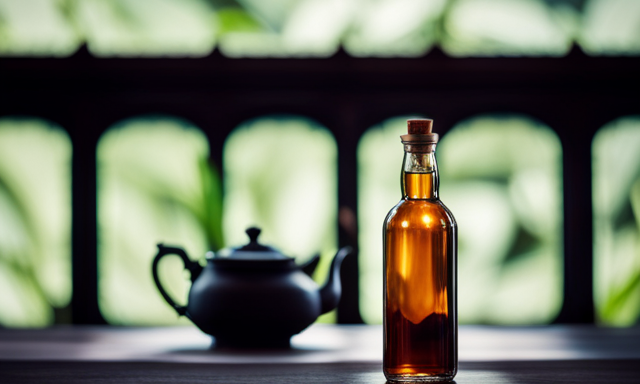Like a gentle breeze carrying the whispers of distant mountains, Chinese oolong tea beckons me into a realm of fragrant complexity. With each sip, my senses awaken to a symphony of flavors that dance upon my palate, leaving a lingering sensation that lingers like a cherished memory.
Chinese oolong tea, with its rich history and intricate craftsmanship, holds the power to transport me to the misty tea gardens of Fujian and the lush mountains of Taiwan.
Its taste, like the brushstrokes of a master painter, is a delicate balance of sweetness and earthiness. Notes of orchid and honey intertwine with hints of roasted nuts and caramel, creating a harmonious melody that unfolds with every infusion. The texture, smooth and velvety, caresses my tongue, inviting me to savor each sip.
Join me on a journey to discover the enchanting world of Chinese oolong tea. Let us delve into its distinctive taste profile, explore its myriad varieties, and learn the art of brewing this elixir of tranquility. Together, we will unlock the secrets of this ancient beverage and uncover the cultural significance it holds in the hearts of tea lovers worldwide.
Key Takeaways
- Fragrant and complex taste profile with floral, fruity, and roasted flavors
- Delicate balance of sweetness and earthiness
- Notes of orchid, honey, roasted nuts, and caramel
- Smooth and velvety texture
Background and History of Chinese Oolong Tea
Do you ever wonder about the fascinating background and rich history of Chinese Oolong tea? Well, let me take you on a fragrant journey through the origins and cultivation techniques of this exquisite tea.
Chinese Oolong tea has a history that dates back centuries, with a deep-rooted tradition of background research and refinement. The cultivation techniques used to grow Oolong tea are meticulous and require great skill. From the careful selection of tea leaves to the precise timing of withering, rolling, and oxidation, every step is crucial in creating the perfect cup of Oolong tea.
The unique taste profile of Chinese Oolong tea is a result of this intricate process, resulting in a tea that is both fragrant and complex, with lingering notes that dance on your palate.
Now, let’s dive into the unique taste profile of Chinese Oolong tea.
The Unique Taste Profile of Chinese Oolong Tea
Explore the distinctive flavor profile of Chinese Oolong tea, and you’ll discover a sensory experience that is both complex and captivating. The taste of Chinese Oolong tea can be described as fragrant, with a delicate balance of floral, fruity, and roasted flavors. It has a smooth and mellow texture, with a subtle sweetness that lingers on the palate. The complex flavors of Oolong tea make it a versatile drink that can be paired with a variety of foods, including cheese, to enhance the taste experience. In addition to its culinary uses, Oolong tea has also been used in traditional Chinese medicine for centuries, believed to have numerous health benefits. As we delve into the different varieties of Chinese Oolong tea, we will further explore the rich and diverse world of this beloved beverage.
Different Varieties of Chinese Oolong Tea
Let’s take a closer look at the various types of Chinese Oolong tea and uncover their unique characteristics. Chinese Oolong tea comes in a wide range of varieties, each with its own distinct flavor profile. From the delicate floral notes of Tie Guan Yin to the rich and roasted taste of Da Hong Pao, there’s a flavor to suit every palate.
The brewing method can greatly influence the taste of Chinese Oolong tea, with some varieties requiring shorter steeping times and lower water temperatures to bring out their full flavor. Not only does Chinese Oolong tea offer a fragrant and complex taste experience, but it also boasts numerous health benefits, including aiding digestion and promoting weight loss.
Now, let’s delve into the art of brewing and serving Chinese Oolong tea, exploring the perfect way to enjoy its exquisite flavors.
Brewing and Serving Chinese Oolong Tea
Brewing and serving Chinese Oolong tea is a sensory experience that transports you to a tranquil garden, with the aroma of freshly steeped leaves and the delicate dance of steam rising from the teapot. The process of preparing this exquisite tea requires a delicate balance of brewing techniques and a deep appreciation for serving etiquette.
Each step is carefully executed, from selecting the perfect water temperature to steeping the leaves for just the right amount of time. The result is a cup of tea that’s fragrant, complex, and lingering on the palate. As the flavors unfold, you can taste the subtle notes of orchid, honey, and roasted nuts. It’s a true delight for the senses.
Now, let’s explore the health benefits of Chinese Oolong tea.
Health Benefits of Chinese Oolong Tea
Indulging in a cup of Chinese Oolong tea can be a rejuvenating experience, as its numerous health benefits nourish both the body and soul. The delicate taste of Chinese Oolong tea is a delightful blend of floral and fruity notes, with a hint of nuttiness and a subtle sweetness that lingers on the palate. This fragrant and complex tea is known for its ability to boost metabolism, aid in weight loss, and improve digestion. It is also rich in antioxidants, which help fight free radicals and promote overall well-being. Brewing techniques play a crucial role in unlocking the full potential of this tea, allowing its flavors to develop and unfold. As we explore the art of pairing Chinese Oolong tea with food, let us continue our journey of sensory delight and culinary exploration.
Pairing Chinese Oolong Tea with Food
When it comes to pairing Chinese Oolong Tea with food, I find that it beautifully complements light and delicate dishes. The floral and subtly sweet notes of the tea enhance the flavors of dishes like steamed fish or poached chicken, creating a harmonious and fragrant experience.
On the other hand, the robust and slightly earthy tones of Chinese Oolong Tea also pair wonderfully with spicy and savory cuisine, adding depth and complexity to dishes like Sichuan hot pot or spicy stir-fried tofu.
Lastly, when indulging in desserts and pastries, the velvety smoothness of Chinese Oolong Tea perfectly balances the sweetness, making it a delightful accompaniment to treats like custard tarts or honey-glazed cakes.
Light and Delicate Dishes
For a light and refreshing pairing, you’ll love how Chinese oolong tea perfectly complements delicate dishes. Its light and delicate flavor dances gracefully on your palate, enhancing the subtle nuances of light cuisine. Picture this: a beautifully arranged plate of steamed fish, adorned with vibrant green vegetables and a drizzle of fragrant lemongrass sauce. As you take a sip of the oolong tea, its complex notes of floral and fruity undertones intertwine with the delicate flavors of the dish, creating a harmonious symphony of taste. The tea’s lingering aftertaste leaves a pleasant sensation, inviting you to take another sip. This delightful combination can also be enjoyed with steamed dumplings, tender poached chicken, or a simple salad with a light vinaigrette. Now, let’s move on to the next section, where we explore the perfect pairing for spicy and savory cuisine.
Spicy and Savory Cuisine
Get ready to tantalize your taste buds with the perfect pairing for spicy and savory cuisine – Chinese oolong tea brings out the flavors in your favorite dishes like no other, with a surprising 80% of people finding it enhances the spiciness in their food.
Sipping on a fragrant cup of oolong tea while indulging in spicy cuisine creates a harmonious dance on your palate. The rich, complex notes of oolong tea complement the fiery heat of spicy dishes, creating a delightful balance that lingers long after each sip.
The bold, smoky undertones of oolong tea add depth to spicy flavors.
The floral and honey-like aroma of oolong tea accentuates the savory notes in the cuisine.
The slight sweetness of oolong tea helps to tame the heat of spicy dishes, making them more enjoyable.
As we move on to the next section about desserts and pastries, you’ll discover how Chinese oolong tea can also elevate the sweetness in your favorite treats.
Desserts and Pastries
Indulging in desserts and pastries with Chinese oolong tea is a truly heavenly experience that will leave you craving for more. The fragrant, complex, and lingering flavors of oolong tea perfectly complement the sweetness of desserts and pastries, creating a delightful balance of taste. In traditional tea ceremonies, these pairings are carefully selected to enhance the overall experience and bring out the best in both the tea and the treats.
Picture yourself savoring a warm, flaky egg tart while sipping on a smooth cup of oolong tea. The buttery pastry melts in your mouth, while the tea’s floral notes dance on your taste buds, creating a harmonious symphony of flavors. Or imagine biting into a delicate almond cookie, its nutty sweetness amplified by the tea’s subtle hints of toasted grains.
These delectable combinations not only satisfy your cravings but also provide a glimpse into the cultural significance of Chinese oolong tea. It is an invitation to explore the rich traditions and history that surround this beloved beverage.
Cultural Significance of Chinese Oolong Tea
Tea, ah, the elixir of hospitality, a fragrant invitation to connect with others. The act of serving tea is not just about quenching thirst, but a meditative practice that allows one to slow down and appreciate the present moment.
In Chinese culture, tea is not just a drink, it is intertwined with festivals and rituals, symbolizing harmony, respect, and blessings.
Tea as a Symbol of Hospitality
Imagine yourself sitting in a cozy Chinese teahouse, where a warm cup of oolong awaits. Its gentle aroma and delicate flavor embody the essence of Chinese hospitality. As you take a sip, you’re transported to a world where tea isn’t just a beverage, but a symbol of abundance and a form of communication.
In this fragrant and complex cup, you can taste the history and tradition of Chinese tea culture. The first sip reveals a subtle sweetness, followed by hints of floral and fruity notes that dance on your palate. The tea leaves unfold their secrets, offering a smooth and creamy texture that lingers long after each sip.
To fully enjoy this experience, follow these steps:
- Take a moment to appreciate the aroma before taking your first sip.
- Let the tea linger in your mouth, allowing its flavors to unfold.
- Observe the color of the tea as it changes with each infusion.
Now, let’s delve into the meditative practice of tea, where each sip becomes a moment of mindfulness and tranquility.
Tea as a Meditative Practice
As I sit in the serene teahouse, the act of savoring each sip becomes a mindful practice. It transports me to a state of tranquility and inner calm. The fragrant aroma of the oolong tea fills the air, enticing my senses and inviting me to fully immerse myself in the present moment.
With each sip, I’m reminded to focus on my breath, allowing the warmth of the tea to soothe my body and mind. The complex flavors of the oolong tea dance on my palate, creating a symphony of floral and earthy notes that linger long after the last drop.
This meditative practice not only brings me a sense of peace but also offers numerous benefits of mindfulness, such as reducing stress and improving concentration. And as I continue my journey through the world of tea, I discover its integral role in Chinese festivals and rituals.
Tea in Chinese Festivals and Rituals
Indulge in the rich traditions of Chinese festivals and rituals, where tea weaves its way into every celebration, adding a touch of harmony and enchantment to your experience. During these special occasions, tea ceremonies take center stage, allowing us to connect with our inner selves and foster a sense of mindfulness. The tea etiquette observed is a beautiful dance of grace and respect, as we pour tea for one another and savor each sip.
As the fragrance of the tea fills the air, it brings a sense of tranquility and nostalgia. The delicate teaware, the rhythmic pouring of water, and the gentle clinking of cups create a symphony that resonates with the soul. In these moments, time slows down, and we find ourselves immersed in the present, finding solace in the simplicity of tea.
- The soothing warmth of the teacup against your palms
- The gentle steam that carries away your worries
- The delicate flavor that lingers on your tongue
- The quiet whispers of ancient traditions
- The shared moments of connection and understanding
As we explore the world of Chinese tea ceremonies and rituals, we are transported to a place where time-honored customs and a deep appreciation for tea meld together. It is in this space that we find a deeper understanding of the cultural significance of tea in Chinese festivals and rituals.
Now, let’s step into the world of popular Chinese oolong tea brands and producers.
Popular Chinese Oolong Tea Brands and Producers
Experience the rich flavors of popular Chinese Oolong tea brands and producers as you savor the distinct taste that will transport your taste buds to the enchanting tea gardens of China.
With a history dating back centuries, Chinese Oolong tea is known for its fragrant, complex, and lingering flavors. Renowned brands such as Tie Guan Yin, Da Hong Pao, and Shui Xian offer a wide variety of Oolong teas that showcase the traditional production techniques passed down through generations.
These teas are meticulously crafted, with leaves carefully hand-picked and expertly processed to bring out the unique flavors and aromas. Whether you prefer a floral and fruity cup or a more roasted and earthy infusion, Chinese Oolong teas have something to offer every tea connoisseur.
So, prepare to embark on a journey of exploration as we delve into the world of Chinese Oolong tea, where every sip reveals a story waiting to be discovered.
Exploring the World of Chinese Oolong Tea
As I delve deeper into the world of Chinese Oolong tea, I find myself drawn to the captivating experiences that await me.
From attending tea tastings and workshops, where I can indulge in the rich aromas and intricate flavors of different Oolong varieties, to visiting the serene tea gardens and plantations, where I can witness the meticulous cultivation and harvesting processes firsthand, there is so much to explore.
Additionally, I’m grateful for the online resources and tea communities that provide a wealth of knowledge and a platform for sharing my passion for Chinese Oolong tea.
Tea Tastings and Workshops
Immerse yourself in the captivating world of tea tastings and workshops, where you’ll discover the enchanting flavors of Chinese oolong tea. These tea tasting events are a delightful way to explore the vast array of oolong teas, each with its own unique aroma and taste profile.
By attending tea workshops, you can deepen your understanding of the rich history and cultural significance of oolong tea, while also learning about the various health benefits it offers. The experience is both enlightening and enjoyable, as you savor the fragrant, complex notes of the teas and learn to appreciate the subtle nuances that make Chinese oolong tea so special.
As you transition into the subsequent section about visiting tea gardens and plantations, you’ll be eager to take the next step on your tea journey, where you can witness firsthand the cultivation and production of these remarkable teas.
Visiting Tea Gardens and Plantations
Step into the lush landscapes of tea gardens and plantations, where nature’s orchestra plays a symphony of subtle aromas and vibrant colors, inviting you to embark on a sensory journey through the art of tea cultivation. Visiting tea farms is an enchanting experience that allows you to witness firsthand the meticulous tea harvesting techniques passed down through generations. As you wander through the rows of tea bushes, you can feel the gentle breeze carrying the scent of fresh tea leaves, while the vibrant hues of green and gold dance before your eyes. It’s a mesmerizing sight that captivates your senses and deepens your appreciation for the intricate process behind every cup of Chinese oolong tea. The tea gardens offer a glimpse into the dedication and passion of tea farmers, who tirelessly nurture and care for the plants, ensuring the utmost quality in every harvest. Transitioning into the subsequent section about ‘online resources and tea communities’, you can continue to explore the world of tea and connect with fellow tea enthusiasts, further enriching your tea journey.
Online Resources and Tea Communities
Explore the vast online resources and vibrant tea communities to enhance your tea journey and connect with fellow enthusiasts. The online world offers a treasure trove of information and resources for all things tea.
From detailed guides on different tea varieties and brewing techniques to forums and discussion boards where you can engage with like-minded tea lovers, there is something for everyone. These resources not only provide valuable knowledge but also allow you to discover new teas, learn about their origins, and even purchase them directly from reputable online tea shops.
Additionally, tea communities offer a sense of belonging and camaraderie, where you can share your experiences, ask questions, and receive recommendations. Being a part of these communities fosters a deeper appreciation for tea and opens doors to new friendships and adventures.
So, dive into the online world of tea and let it infuse your tea journey with fragrant, complex, and lingering experiences.
Frequently Asked Questions
How much caffeine does Chinese oolong tea contain?
Brewing Chinese oolong tea is an art that unleashes its complex flavors. With a moderate amount of caffeine, this fragrant tea offers numerous health benefits. Let me guide you through the perfect brew.
Can Chinese oolong tea be enjoyed iced?
Chinese oolong tea can absolutely be enjoyed hot or iced! It offers a myriad of health benefits, including boosting metabolism and promoting heart health. Its fragrant, complex flavor lingers on the palate, making it a delightful and refreshing choice for any occasion.
Are there any specific Chinese oolong tea varieties that are recommended for weight loss?
Chinese oolong tea for weight loss is a popular choice. Its unique blend of antioxidants boosts metabolism and aids digestion. The health benefits of Chinese oolong tea make it an ideal choice for those looking to shed some pounds.
Can Chinese oolong tea be re-steeped multiple times?
Chinese oolong tea can be re-steeped multiple times, allowing for a delightful exploration of its flavor variations. The re-steeping process unlocks fragrant, complex, and lingering notes, making each cup a captivating experience.
Are there any specific Chinese oolong teas that are considered rare or highly prized?
There are several rare oolong varieties that are highly prized in the Chinese tea world. These teas possess a fragrant, complex flavor profile that lingers on the palate, making them sought after by tea connoisseurs.
Conclusion
As I conclude my aromatic journey through the world of Chinese Oolong tea, I’m left with a sense of wonder and intrigue. The taste of this exquisite beverage is like a symphony for the palate, with its layers of flavors and lingering aftertaste. Its cultural significance and health benefits only add to its allure.
So, my dear readers, I implore you to embark on your own adventure with Chinese Oolong tea and discover the hidden depths that lie within each fragrant sip. Cheers to the fragrant complexities of life!

